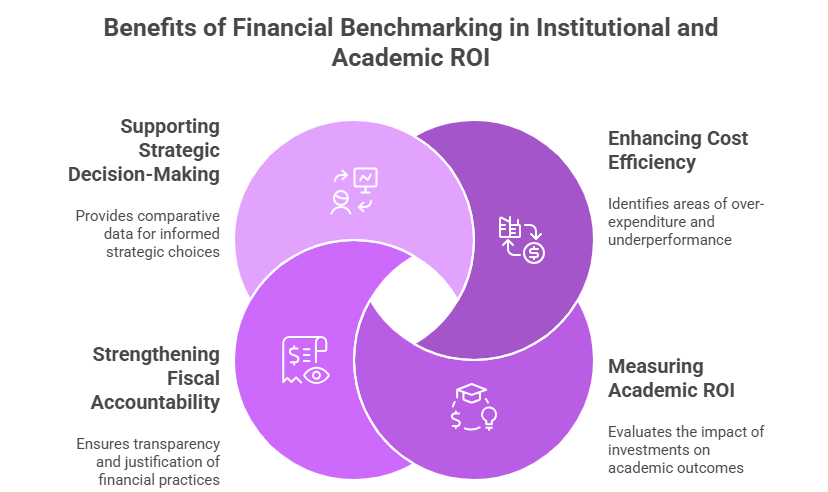The global education sector is at a pivotal crossroads, balancing the pursuit of academic excellence with the pressing need for financial sustainability. Institutions worldwide are navigating shifting funding models, rising operational costs, digital transformation pressures, and evolving student expectations. In this dynamic environment, financial clarity has become as critical as academic innovation.
While universities and education networks continue to expand their digital programs, research capabilities, and global partnerships, many face a key challenge: how to measure the financial effectiveness of these investments. Are academic outcomes proportionate to resource utilization? Is the institution’s cost structure aligned with long-term sustainability? And how does its financial performance compare globally?
This is where Global Education Financial Benchmarking Studies bring transformative value. By assessing parameters such as cost per student, revenue-to-expense ratios, faculty productivity, operational margins, and ROI on academic programs, benchmarking helps institutions identify inefficiencies, strengthen fiscal health, and sustain their academic mission with measurable financial intelligence.
Why Financial Benchmarking Is Critical for Institutional Sustainability and Academic ROI
In the post-digital transformation era, educational institutions face a dual challenge of delivering high-quality learning experiences while maintaining financial and operational sustainability. Endowment volatility, rising infrastructure costs, and student affordability pressures have made financial benchmarking an essential governance tool for universities, schools, and private academic networks worldwide.

- Enhancing Institutional Cost Efficiency: By benchmarking cost per enrolled student, faculty cost productivity, and digital adoption ROI, institutions can pinpoint areas of over-expenditure or underperformance. This data helps reallocate funds toward initiatives that deliver measurable academic or operational value.
- Measuring Academic ROI Beyond Traditional Metrics: Academic excellence is about return on academic investment. Benchmarking helps institutions measure how investments in faculty development, digital infrastructure, and learning innovation translate into improved graduation rates, student employability, and overall financial sustainability.
- Strengthening Fiscal Accountability and Governance: Boards, donors, and accreditation bodies increasingly demand transparency. Benchmarking creates standardized financial metrics that make it easier for institutions to report, evaluate, and justify capital utilization, operating expenses, and revenue performance.
- Supporting Strategic Decision-Making: Benchmarking provides comparative visibility into how peer institutions across regions and ownership models (public, private, hybrid) are managing financial pressures. This helps academic leaders make data-backed strategic choices around tuition models, expansion plans, and funding diversification.
Nexdigm’s Global Education Financial Benchmarking Framework
At Nexdigm, we help educational institutions and academic networks transform financial benchmarking into a strategic intelligence tool that aligns academic excellence with fiscal sustainability. Our Global Education Financial Benchmarking Framework provides universities, EdTech-enabled institutions, and private education groups with comparative insights that go beyond numbers, connecting financial performance with academic outcomes.
Stage 1: Global Peer and Institutional Mapping
We begin by identifying a relevant benchmarking universe, grouping institutions by scale, ownership (public/private), specialization, and digital maturity. This ensures that each comparison reflects a realistic context for performance evaluation.
Stage 2: Financial and Academic KPI Benchmarking
Nexdigm benchmarks key indicators such as revenue per student, faculty cost ratio, operating margin, endowment utilization, cost per digital program, and academic ROI per department. These insights reveal efficiency gaps and highlight areas of competitive advantage.
Stage 3: Resource Allocation and Efficiency Assessment
Our consultants evaluate how institutions allocate resources across academics, research, infrastructure, and digital transformation. By linking spending with output performance, we identify where capital investments yield the highest returns in both financial and academic terms.
Stage 4: Academic ROI and Performance Modeling
Through advanced financial modeling, we quantify how institutional investments in curriculum innovation, technology enablement, and student services translate into measurable ROI. This modeling helps leadership teams assess program-level performance and simulate long-term fiscal outcomes.
Stage 5: Strategic Dashboard and Sustainability Blueprint
All findings are presented in a Global Education Financial Benchmarking Dashboard, offering a clear, visual understanding of key performance metrics. Nexdigm then delivers a Sustainability Blueprint, strategic roadmap that outlines actionable recommendations to enhance efficiency, financial resilience, and academic ROI.
Nexdigm’s benchmarking framework transforms education management from reactive cost control to strategic financial stewardship, empowering institutions to achieve a balance between quality, impact, and sustainability.
To take the next step, simply visit our Request a Consultation page and share your requirements with us.
Harsh Mittal
+91-8422857704

